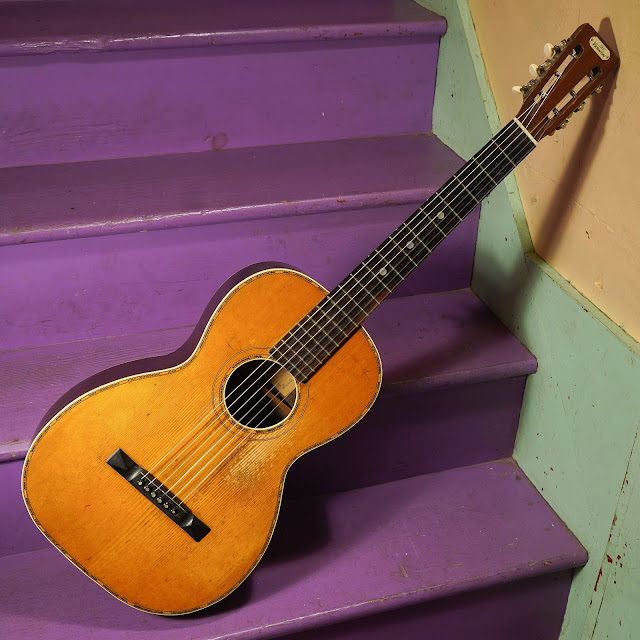1900s The Vernon (Likely Bauer) Parlor Guitar
This is a bit of a "mystery" guitar. At first glance it looks a lot like a Regal-made instrument but on closer inspection I think it has to have been made by Bauer. It has similar ladder-bracing (with the flatter lower back braces) to Bauer instruments, a very similar body shape and heel shape/size, similar scale length, and similar trim and fittings to Bauers I've worked on. I can't claim it as one but I'm fairly certain it is.
It was built in a time when a pin-bridge guitar would have been intended for gut strings, so I've strung it with classical strings (gut's modern equivalent) and left the intonation "straight" at the bridge. While I would not suggest using steel strings of the normal variety on this, to get a "steelier" sound, Thomastik KR116 strings would be ideal. They're rope-core-steel and sound and handle like steel but intonate and tension like classical strings.
There are slightly quirky things about the instrument but overall it's a pretty lovely little thing. It's a hair smaller than "0 size" and makes an excellent couch-potato guitar. It's best, of course, as a fingerpicker but does sound nice with light-medium strumming.
Did I mention the back and sides are Brazilian rosewood? Hubba hubba at that...
Repairs included: (previously) a fret level/dress, bridge pin holes fill/redrill, replacement (vintage) saddle wire, minor re-repair to old hairline crack repairs, setup, etc.
Weight: 2 lbs 14 oz
Scale length: 24 5/8"
Nut width: 1 13/16"
Neck shape: medium V
Board radius: flat
Body width: 12 5/8"
Body depth: 3 3/4"
Top wood: solid spruce
Back & sides wood: solid Brazilian rosewood
Bracing type: ladder
Bridge: ebony
Fretboard: rosewood
Neck wood: mahogany
Action height at 12th fret: 3/32” overall (fast, spot-on)
String gauges: medium-tension nylon
Neck relief: straight
Fret style: lower/smaller
Condition notes: it has a few hairline cracks on the back which are a little longer but filled/sealed and holding steady. There's general wear and tear throughout the finish everywhere but, overall, it looks pretty good for its age despite that and the pickwear around the soundhole. The bridge had been shaved in the past and the pinholes moved to realign them better with the neck. The original fret saddle was broken, as I recall, so I made-up a "new one" in similar gauge to the original by using a pair of vintage fret wires that matched the original size well enough. The tuners are not original and turn backwards when using them and cranking as-normal, but due to the slotted headstock design this is a non-issue, really. Some of the bridge pins are originals and others are period replacements. The nut is not original.
It comes with: a gigbag.























Comments